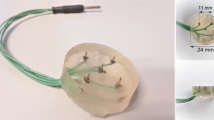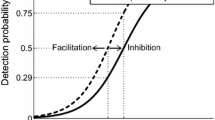Abstract
For predicting the temperature distribution within skin tissue in 980-nm laser-evoked potentials (LEPs) experiments, a five-layer finite element model (FEM-5) was constructed based on Pennes bio-heat conduction equation and the Lambert-Beer law. The prediction results of the FEM-5 model were verified by ex vivo pig skin and in vivo rat experiments. Thirty ex vivo pig skin samples were used to verify the temperature distribution predicted by the model. The output energy of the laser was 1.8, 3, and 4.4 J. The laser spot radius was 1 mm. The experiment time was 30 s. The laser stimulated the surface of the ex vivo pig skin beginning at 10 s and lasted for 40 ms. A thermocouple thermometer was used to measure the temperature of the surface and internal layers of the ex vivo pig skin, and the sampling frequency was set to 60 Hz. For the in vivo experiments, nine adult male Wistar rats weighing 180 ± 10 g were used to verify the prediction results of the model by tail-flick latency. The output energy of the laser was 1.4 and 2.08 J. The pulsed width was 40 ms. The laser spot radius was 1 mm. The Pearson product-moment correlation and Kruskal-Wallis test were used to analyze the correlation and the difference of data. The results of all experiments showed that the measured and predicted data had no significant difference (P > 0.05) and good correlation (r > 0.9). The safe laser output energy range (1.8–3 J) was also predicted. Using the FEM-5 model prediction, the effective pain depth could be accurately controlled, and the nociceptors could be selectively activated. The FEM-5 model can be extended to guide experimental research and clinical applications for humans.















Similar content being viewed by others
References
Spiegel J, Hansen C, Treede RD (2000) Clinical evaluation criteria for the assessment of impaired pain sensitivity by thulium-laser evoked potentials. Clin Neuro physiol 111:725–735
Julius D, Basbaum AI (2001) Molecular mechanisms of nociception. Nature 413:203–210
Bromm B, Treede RD (1983) CO2 laser radiant heat pulses activate C nociceptors in man. Pflugers Archive 399:155–156
Brugmans MJ, Kemper J, Gijsbers GH, van der Meulen FW, van Gemert MJ (1991) Temperature response of biological materials to pulsed non-ablative CO2 laser irradiation. Lasers Surg Med 11:587–594
Lu PL, Hsu SS, Tsai ML, Jaw FS, Wang AB, Yen CT (2012) Temporal and spatial temperature distribution in the glabrous skin of rats induced by short-pulse CO2 laser. J Biomed Opt 17:117002
Tillman DB, Treede RD, Meyer RA, Campbell JN (1995) Response of C fibre nociceptors in the anaesthetized monkey to heat stimuli: estimates of receptor depth and threshold. J Physiol 485:753–765
Treede RD (1996) Assessment of thin C fiber and anterolateral-tract function with laser evoked potentials. Amsterdam: Elsevier 27:323–327
Kou L, Labrie D, Chylek P (1993) Refractive indices of water and ice in the 0.65 to 2.5 μm spectral range. App Opt 32:3531–3540
Walsh JT Jr, Flotte TJ, Deutsch TF (1989) Er:YAG laser ablation of tissue: effect of pulse duration and tissue type on thermal damage. Lasers Surg Med 9:314–326
Pope RM, Fry ES (1997) Absorption spectrum (380-700 nm) of pure water. II. Integrating cavity measurements. App Opt 36:8710–8723
Gülsoy M, Durak K, Kurt A, Karamürsel S, Cilesiz I (2001) The 980 nm diode laser as a new stimulant for laser evoked potentials studies. Lasers Surg Med 28:244–247
Durak K, Chen AC, Arendt-Nielsen L (2004) 3D topographic study of the diode laser evoked potentials (LEPs) to painful stimulation of the trigeminal sensory area. Brain Topogr 16:133–138
Mohammed Y, Verhey JF (2005) A finite element method model to simulate laser interstitial thermo therapy in anatomical inhomogeneous regions. Biomed Eng Online 4:2
Roggan A, Mesecke-von Rheinbaben I, Knappe V, Vogl T, Mack MG, Germer C, Albrecht D, Müller G (1997) Applicator development and irradiation planning in laser-induced thermotherapy (LITT). Biomed Tech (Berl) 42:332–333
Marchandise E, Mouraux A, Plaghki L, Henrotte F (2014) Finite element analysis of thermal laser skin stimulation for a finer characterization of the nociceptive system. J Neurosci Methods 223:1–10
Al-Saadi MH, Nadeau V, Dickinson MR (2006) A novel modelling and experimental technique to predict and measure tissue temperature during CO2 laser stimuli for human pain studies. Lasers Med Sci 21:95–100
Frahm KS, Andersen OK, Arendt-Nielsen L, Mrch CD (2010) Spatial temperature distribution in human hairy and glabrous skin after infrared CO2 laser radiation. Biomed Eng Online 9:69
Plaghki L, Mouraux A (2003) How do we selectively activate skin nociceptors with a high power infrared laser? Physiology and biophysics of laser stimulation. Neuro Physiol Clin 33:269–277
Shafirstein G, Bäumler W, Lapidoth M, Ferguson S, North PE, Waner M (2004) A new mathematical approach to the diffusion approximation theory for selective photothermolysis modeling and its implication in laser treatment of port-wine stains. Lasers Surg Med 34:335–347
Kaufmann R, Hartmann A, Hibst R (1994) Cutting and skin-ablative properties of pulsed mid-infrared laser surgery. J Dermatol Surg Oncol 20:112–118
Shaw FZ, Chen RF, Tsao HW, Yen CT (1999) Comparison of touch- and laser heat-evoked cortical field potentials in conscious rats. Brain Res 824:183–196
Qiao ZM, Wang JY, Han JS, Luo F (2008) Dynamic processing of nociception in cortical network in conscious rats: a laser-evoked field potential study. Cell Mol Neurobiol 28:671–678
Greffrath W, Nemenov MI, Schwarz S, Baumgärtner U, Vogel H, Arendt-Nielsen L, Treede RD (2002) Inward currents in primary nociceptive neurons of the rat and pain sensations in humans elicited by infrared diode laser pulses. Pain 99:145–155
Truini A, Romaniello A, Galeotti F, Iannetti GD, Cruccu G (2004) Laser evoked potentials for assessing sensory neuropathy in human patients. Neurosci Lett 367:25–28
Author information
Authors and Affiliations
Corresponding author
Ethics declarations
All experiments were carried out in accordance with the Institutional Animal Care and Use Committee of Peking Union Medical College (Animal Experimental Ethical Number: 2016-004). All methods were taken to minimize animal suffering. This study does not involve human trials; thus, informed consent is not necessary.
Conflict of Interest
The authors declare that they have no conflict of interest.
Contract Grant Sponsor
This work is supported by the fundamental research funds for the central universities (Grant number 2016RC310022). The funders of the study had no role in study design, data collection, data analysis, data interpretation, or writing of the report. The corresponding author had full access to all the data in the study and had final responsibility for the decision to submit for publication.
Rights and permissions
About this article
Cite this article
Wang, H., Dong, XX., Yang, JC. et al. Finite element method simulating temperature distribution in skin induced by 980-nm pulsed laser based on pain stimulation. Lasers Med Sci 32, 1173–1187 (2017). https://doi.org/10.1007/s10103-017-2223-9
Received:
Accepted:
Published:
Issue Date:
DOI: https://doi.org/10.1007/s10103-017-2223-9




